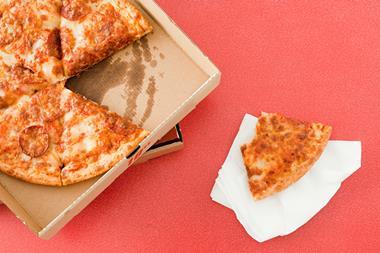
M&S is having conversations with suppliers about removing ingredients associated with ultra-processed food in order to continue benefiting from its Eat Well label.
However, the job is understood to be proving difficult in the context of wider ongoing debate over what UPF means and how important it is to public health outcomes, and amid pushback from suppliers.
M&S’s Eat Well range currently includes ready meals with more than 30 ingredients, among them stabilisers. Also bearing the Eat Well label are tinned veg with acidity regulators, antioxidants or firming agents, and loaves with emulsifiers – all ingredients that have been associated with UPF.
The Eat Well sunflower logo is pitched to consumers as a seal of approval “highlighting a healthy choice, with criteria based on the government’s Eatwell Guide and endorsed by the British Nutrition Foundation”.
A source said M&S was “having the same conversation with much of their supplier base” about changing the Eat Well criteria “in an attempt to get it to mean ‘not UPF’”.
“They are trying to bring in some ingredient changes, but it’s not proving easy. It’s the same question all supermarkets are asking. Removing an ingredient does not necessarily stop a product from being UPF.”
It is understood the challenge is being complicated for M&S by a lack of alignment between notions of UPF and government guidance, including the nutrient profiling model, which awards products a score based on nutritional content per 100g.
“My impression is they’ve got themselves in a real muddle, not just because manufacturers can’t or won’t budge, but also because they’re chasing a target that doesn’t really score any points, and that’s slowly becoming apparent,” said the source.

M&S said it was not redefining Eat Well but continuously evolved the criteria to keep up with latest nutrition science, supported and endorsed by the British Nutrition Foundation.
A spokeswoman said 50% of M&S Food sales last year were from products defined as healthier under current government guidance and the target was to grow that to 70% by 2025.
“In 2005, we launched our Eat Well Sunflower logo to provide an easy-to-understand signpost towards healthier choices for customers,” she said.
“An M&S product only achieves the Eat Well health seal of approval if it fulfils evidence-based, nutritional criteria informed by the government’s Eat Well guide. In 2022, we extended the Eat Well brand to support our biggest ever health campaign, Eat Well Play Well, by partnering with the UK’s national football teams and the FA to use the power of football to encourage families to make healthier food choices.
“Quality underpins everything at M&S and as part of that we continually review and reformulate our products to evolve our ‘no unnecessary ingredients’ approach, listening to customers and industry experts.
“Our approach to using only store cupboard ingredients is industry-leading and this is one of the factors that helps us maintain our number one position on quality.”
She said M&S had been recognised in a YouGov UK BrandIndex survey between April 2023 and March 2024 as the leading retailer for healthy choices.
Read more:
-
Will Mars-Kellanova deal signal a UPF black hole?
-
M&S cuts chicken stocking densities in latest animal welfare commitment
-
What’s on the food to-do list for the new Labour government?
Research for The Grocer in May found negative sentiment to UPF was growing among MPs from all parties following the high-profile campaigning of figures such as Dr Chris van Tulleken and Professor Tim Spector.
However, critics of the anti-UPF movement argue it is not underpinned by scientific evidence.
“In fact, it turns the UK’s clear, established dietary guidance on its head, making it harder for shoppers to choose what to eat and drink,” FDF CEO Karen Betts recently wrote for The Grocer.
“Should we buy supermarket wholegrain bread, pasta sauce or low-calorie yoghurts and drinks, which are healthy choices according to government guidance but also UPF? Or should we choose full-sugar options and locally made, higher-salt bread, to avoid consuming a UPF?”



















1 Readers' comment